Herkimer DiamondsDoubly terminated quartz crystals named for Herkimer County, New York |
|||||||||||||||||||
The host rock for Herkimer Diamonds is the Cambrian-age, Little Falls Dolostone. The Little Falls Dolostone was deposited about 500 million years ago and the Herkimer Diamonds formed in cavities within the dolostone. These cavities are frequently lined with drusy quartz crystals and often are coated with a tarry hydrocarbon (see image below). Although Herkimer County, New York is the location for which these crystals are named, similar doubly terminated quartz crystals have been found in a few other locations, including Arizona, Afghanistan, Norway, Ukraine and China. They have the same appearance but can not rightfully be called "Herkimers". The doubly terminated quartz crystals shown in the lower right photo are from a deposit in Afghanistan.
Who Discovered Herkimer Diamonds?The Herkimer Diamonds of New York are not a recent discovery. The Mohawk Indians and early settlers knew about the crystals. They found them in stream sediments and plowed fields. These people were amazed with the crystals and immediately held them in high esteem. Herkimer Diamond MinesSome of the best places to find Herkimer Diamonds today are located along New York State Route 28 in Middleville, New York. (When visiting this area it is important to remember that all land in New York either belongs to the government or is private property. Collecting minerals from government lands is illegal in New York and collecting on private property always requires permission in advance.) There are two commercial mines on New York State Route 28 at Middleville, New York. These are: Ace of Diamonds Mine and Herkimer Diamond Mine. Both allow collectors to enter and prospect for a nominal fee. Both locations also rent equipment such as hammers, wedges and other small tools. They also have small exhibit areas where you can view and/or purchase specimens. Mining for Herkimer DiamondsThe key to finding Herkimer Diamonds is a knowledge that they occur in cavities (vugs) within the Little Falls Dolostone (see photo above). These cavities can be smaller than a pea or several feet across. At both of the mines listed above the Little Falls Dolostone is exposed at the surface and a significant amount of broken rock is scattered across the quarry floor. "Find and Break" ProspectingDolomite is a very tough rock so expect to work hard. The use of safety glasses is required and wise collectors wear gloves to protect their hands. We always wear jeans or heavy long pants and a long sleeve shirt for "find and break" prospecting. Small pieces of dolomite will sometimes fly when a rock breaks and they can easily cut or bruise a person wearing short pants. The "find and break" prospecting method described above is employed by many people who visit these mines and can lead to a few good finds. The keys to success are selection of good rocks to break and not being discouraged if you break fifty rocks without finding a crystal. (See image below to know what "vuggy rock" looks like. Click the image for a closer view.) 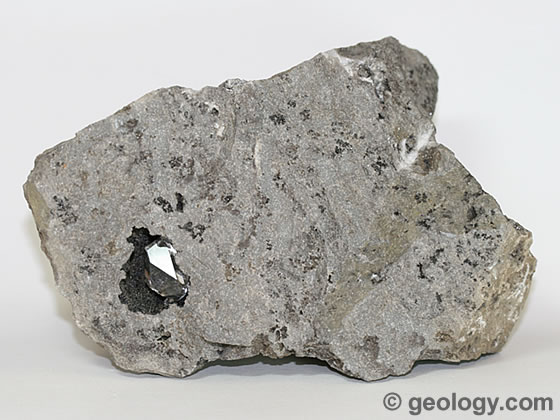 Vuggy rock containing a nice Herkimer Diamond. Rock is about six inches across. "Scavenger" ProspectingSome visitors to the mines have been successful by simply searching the rock rubble for exposed crystals or searching the quarry floor for loose crystals. We found several really nice crystals this way and lots of tiny ones. We have also seen children find many nice crystals this way. "Cavity" ProspectingFor finding large quanties of crystals, the most successful mining method is to break into large cavities in the quarry walls and floors using sledge hammers and wedges (power equipment is not permitted at the mines listed in this article). This method requires tools, patience, time and a knowledge of how to break an extremely durable dolostone.
The cavity shown above was opened by Anne and Bill. It contained over one hundred quartz crystals in a variety of sizes, ranging from a few millimeters to several centimeters in length. A very nice prize for a day's work! Two large clusters from the cavity are shown below
Herkimer Diamond Specimens & JewelryWhy hunt for Herkimer Diamonds? It's great fun and every time you break open a rock you will look with anticipation to see if you liberated an unseen quartz crystal. Nice Herkimer Diamonds are highly prized mineral specimens and are sought by mineral collectors worldwide. Large numbers of Herkimer crystals are also used in jewelry because their natural facets are both beautiful and interesting. Some people also seek Herkimer diamonds because they are thought to have "holistic qualities". If you like minerals and have an opportinity to visit the Herkimer County area of New York, consider spending a day looking for Herkimer Diamonds. Be sure to wear clothes that are suitable for working outdoors. Safety glasses are required and you will be sorry if you don't wear gloves. If you need a sledge hammer or other tools you can rent them at the mine for a very small fee. If you want to obtain some nice Herkimer Diamonds but are unable to visit Herkimer to mine them yourself please visit Bill's site at HerkimerDiamonds.ca. | |||||||||||||||||||
Hipty
Tuesday, 16 July 2013
Herkimer Diamonds
What Causes a Tsunami?
What Causes a Tsunami?
What causes a tsunami?... A tsunami is a large ocean wave that is caused by sudden motion on the ocean floor. This sudden motion could be an earthquake, a powerful volcanic eruption, or an underwater landslide. The impact of a large meteorite could also cause a tsunami. Tsunamis travel across the open ocean at great speeds and build into large deadly waves in the shallow water of a shoreline.
Subduction Zones are Potential Tsunami Locations
Most tsunamis are caused by earthquakes generated in a subduction zone, an area where an oceanic plate is being forced down into the mantle by plate tectonic forces. The friction between the subducting plate and the overriding plate is enormous. This friction prevents a slow and steady rate of subduction and instead the two plates become "stuck".

Accumulated Seismic Energy
As the stuck plate continues to descend into the mantle the motion causes a slow distortion of the overriding plage. The result is an accumulation of energy very similar to the energy stored in a compressed spring. Energy can accumulate in the overriding plate over a long period of time - decades or even centuries.
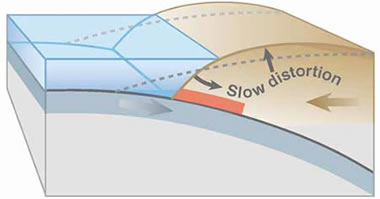
Earthquake Causes Tsunami
Energy accumulates in the overriding plate until it exceeds the frictional forces between the two stuck plates. When this happens, the overriding plate snaps back into an unrestrained position. This sudden motion is the cause of the tsunami - because it gives an enormous shove to the overlying water. At the same time, inland areas of the overriding plate are suddenly lowered.

Tsunami Races Away From the Epicenter
The moving wave begins travelling out from where the earthquake has occurred. Some of the water travels out and across the ocean basin, and, at the same time, water rushes landward to flood the recently lowered shoreline.
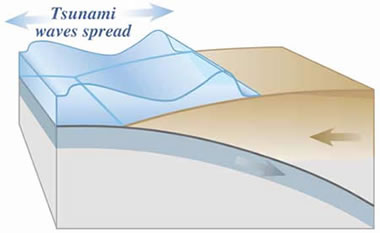
Tsunamis Travel Rapidly Across Ocean Basis
Tsunamis travel swiftly across the open ocean. The map below shows how a tsunami produced by an earthquake along the coast of Chile in 1960 traveled across the Pacific Ocean, reaching Hawaii in about 15 hours and Japan in less than 24 hours.
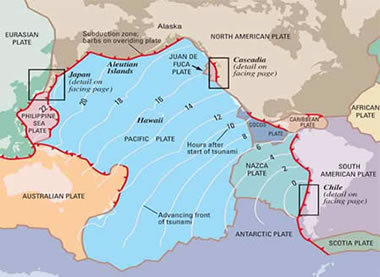
Tsunami "Wave Train"
Many people have the mistaken belief that tsunamis are single waves. They are not. Instead tsunamis are "wave trains" consisting of multiple waves. The chart below is a tidal gauge record from Onagawa, Japan beginning at the time of the 1960 Chile earthquake. Time is plotted along the horizontal axis and water level is plotted on the vertical axis. Note the normal rise and fall of the ocean surface, caused by tides, during the early part of this record. Then recorded are a few waves a little larger than normal followed by several much larger waves. In many tsunami events the shoreline is pounded by repeated large waves.

Monday, 15 July 2013
This Trike Motorcycle Concept Is Like A Big Wheel For Adults

TrailTrike Concept by Charles Bombardier
IMAGE BY Brian Miller
Cars
//
There's something about being perched above three
massive plastic wheels that imbues ordinary crybaby toddlers with a
terrifyingly kick-ass, gelled-hair attitude. Unfortunately, there's
something about adult trikes that is really, really uncool. Now designer
Charles Bombardier, one of the creators of the three-wheeled Spyder
roadster and grandson of the inventor of the snowmobile, has developed a
trike motorcycle concept that looks just as fabulous to ride as your
childhood Big Wheel.
Unlike the Big Wheel, the Trail Trike concept
has two wheels in front and one in back. Bombardier designed the
motorcycle concept to ride on asphalt as well as dirt roads and trails.
The seat is another invention of Bombardier's: To help maintain balance
on bumpy backroads, the motorized "carving seat" tilts at various angles and speeds to respond to how a rider leans during turns and acceleration.
Bombardier tells Popular Science that he also imagines the TrailTrike with a so-called intelligent stability system, in which a rider can input a certain type of terrain (dirt, snow, or asphalt), and an algorithm will adjust engine power supply, braking on each wheel, and traction control as needed.
Powering the trike would be a 165-hp, 2-stroke, direct-injection engine with a continuously variable transmission. Two output shafts would provide power to each wheel. In order to concentrate most of the motorcycle's mass around its center of gravity-thus making it easier to handle-Bombardier mounted the front disc brakes on the chassis of the vehicle instead of on the wheel hubs.
Bombardier tells Popular Science that he also imagines the TrailTrike with a so-called intelligent stability system, in which a rider can input a certain type of terrain (dirt, snow, or asphalt), and an algorithm will adjust engine power supply, braking on each wheel, and traction control as needed.
Powering the trike would be a 165-hp, 2-stroke, direct-injection engine with a continuously variable transmission. Two output shafts would provide power to each wheel. In order to concentrate most of the motorcycle's mass around its center of gravity-thus making it easier to handle-Bombardier mounted the front disc brakes on the chassis of the vehicle instead of on the wheel hubs.
What did giant extinct vampire bats eat?
What did giant extinct vampire bats eat?

Macrauchenia having a really bad
day in the Pleistocene. This scene >>is a parody and almost
certainly never happened<<. Tet Zoo dollars to whomever recognises
the obvious derivation. Illustration by Darren Naish.

Skull of Desmodus rotundus,
showing amazing dentition. Image by Mokele, licensed under Creative
Commons Attribution 3.0 Unported license.
But it gets better: there are numerous additional fossil vampires. They include Desmodus archaeodaptes from the Upper Pliocene of Florida (this is the oldest reported vampire species), De. stocki from the USA and Mexico, the Cuban endemic form De. puntajudensis, De. draculae from Venezuela, Belize and Brazil, and an unnamed related form from Buenos Aires, Argentina. De. stocki – sometimes known as Stock’s vampire – was 15-20% bigger than the extant Common vampire. Indeed, a specimen now included within this species was originally named De. magnus. De. draculae – sometimes referred to as a ‘giant vampire’ – was about 25% bigger than a modern Common vampire, suggesting a wingspan of perhaps 50 cm and a mass of about 60 g. This makes it on par with a large horseshoe bat or small fruit bat: keep in mind that the majority of ‘microbats’ weigh between 10 and 20 g!
What sort of animals were these fossil vampires feeding from? Of the living vampires, both the Hairy-legged vampire and White-winged vampire mostly prey on birds. However, the Common vampire mostly preys on mammals, and because the fossil species are all members of the genus Desmodus, it’s reasonable to assume that they, also, mostly fed on mammals. However, they surely exploited other prey when they were available. Here’s a wholly speculative reconstruction of a Pleistocene Desmodus feeding from the leg of a sleeping teratorn (aka teratornithid). Teratorns are giant, condor-like birds; the last time I used a version of this image I was reminded that they likely defecated down their legs as living New World vultures do today. Nevertheless, I’m sure the bat is safe in this particular instance…

Pleistocene Desmodus feeds from sleeping teratorn. Image by Darren Naish.

An extinct Pleistocene vampire
(probably Desmodus stocki) feeding from a giant sloth. Illustration by
Randy Babb, from Brown (1994).
Intriguingly, the morphology of some of
these vampires suggests that they differed in ecology and behaviour from
the living vampire species. Both De. archaeodaptes and the Cuban species De. puntajudensis
seems to have had far more freedom of movement in their jaw joint that
the Common vampire, a feature suggesting that they somehow differed in
how they procured and/or bit their prey (Morgan 1991, Suarez 2005). The
robust hindlimb bones of De. puntajudensis and De. stocki
also suggest that their style of terrestrial locomotion differed from
that of the Common vampire, though exactly how it differed remains
unknown. The large size of De. stocki, De. draculae
and the Argentinean giant form of course indicate that they fed on
larger prey than living vampires and, as noted, these fossil bats are
sometimes found associated with ground sloths.
Bats have been covered on Tet Zoo quite a bit: there’s lots in the
archives on vampires and vespertilionids in particular. However, there
is still tons and tons to get through!50-year-old assumptions about strength muscled aside
50-year-old assumptions about strength muscled aside

Argonne National Laboratory
The basics of how a muscle generates power remain the same: Filaments of myosin tugging on filaments of actin shorten, or contract, the muscle -- but the power doesn't just come from what's happening straight up and down the length of the muscle, as has been assumed for 50 years.
Instead, University of Washington-led research shows that as muscles bulge, the filaments are drawn apart from each other, the myosin tugs at sharper angles over greater distances, and it's that action that deserves credit for half the change in muscle force scientists have been measuring.
Researchers made this discovery when using computer modeling to test the geometry and physics of the 50-year-old understanding of how muscles work. The computer results of the force trends were validated through X-ray diffraction experiments on moth flight muscle, which is very similar to human cardiac muscle. The X-ray work was led by co-author Thomas Irving, an Illinois Institute of Technology professor and director of the Biophysics Collaborative Access Team (Bio-CAT) beamline at the Advanced Photon Source, which is housed at the U.S. Department of Energy's Argonne National Laboratory.
A previous lack of readily available access to computational power and X-ray diffraction facilities are two reasons that this is the first time these findings have been documented, speculated lead-author C. David Williams, who earned his doctorate at the UW while conducting the research, and now is a postdoctoral researcher at Harvard University. Currently, X-ray lightsources have a waiting list of about three researchers for every one active experiment. The APS is undergoing an upgrade that will greatly increase access and research power and expedite data collection.
The new understanding of muscle dynamics derived from this study has implications for the research and use of all muscles, including organs.
"In the heart especially, because the muscle surrounds the chambers that fill with blood, being able to account for forces that are generated in several directions during muscle contraction allows for much more accurate and realistic study of how pressure is generated to eject blood from the heart," said co-author Michael Regnier, a UW bioengineering professor. "The radial and long axis forces that are generated may be differentially compromised in cardiac diseases and these new, detailed models allow this to be studied at a molecular level for the first time. They also take us to a new level in testing therapeutic treatments targeted to contractile proteins for both cardiac and skeletal muscle diseases. "
This study gives scientists and doctors a new basis for interpreting experiments and understanding the mechanisms that regulate muscle contraction. Researchers have known for sometime that the muscle filament lattice spacing changes over the length-tension curve, but its importance in generating the steep length dependence of force has not been previously demonstrated.
"The predominant thinking of the last 50 years is that 100 percent of the muscle force comes from changes as muscles shorten and myosin and actin filaments overlap. But when we isolated the effects of filament overlap we only got about half the change in force that physiologists know muscles are capable of producing," Williams said.
The rest of the force, he said, should be credited to the lattice work of filaments as it expands outward in bulging muscle -- whether in a body builder's buff biceps or the calves of a sinewy marathon runner.
"One of the major discoveries that David Williams brought to light is that force is generated in multiple directions, not just along the long axis of muscle as everyone thinks, but also in the radial direction," said Thomas Daniel, UW professor of biology and co-author on the paper.
"This aspect of muscle force generation has flown under the radar for decades and is now becoming a critical feature of our understanding of normal and pathological aspects of muscle," Daniel added.
Since the 1950s scientists have had a formula -- the so-called length-tension curve -- that accurately describes the force a muscle exerts at all points from fully outstretched, when every weight lifter knows there is little strength, to the middle points that display the greatest force, to the completely shortened muscle when, again, strength is minimized.
Williams developed computer models to consider the geometry and physics at work on the filaments at all those points.
"The ability to model in three dimensions and separate the effects of changes in lattice spacing from changes in muscle length wouldn't even have been possible without the advent of cloud computing in the last 10 years, because it takes ridiculous amounts of computational resources," Williams said.
Subscribe to:
Comments (Atom)
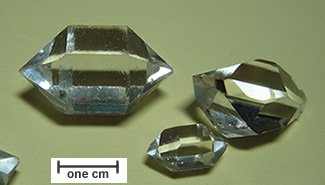
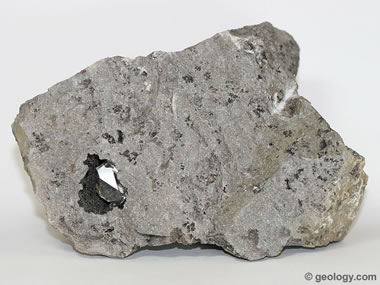 Cavity with drusy quartz, hydrocarbon and a nice diamond. Rock is 6" across. Zoom in for detail.
Cavity with drusy quartz, hydrocarbon and a nice diamond. Rock is 6" across. Zoom in for detail.  "Herkimer Diamonds" found in Afghanistan. Similar crystals are found at several locations.
"Herkimer Diamonds" found in Afghanistan. Similar crystals are found at several locations.
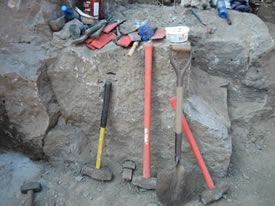 Some of Bill McIlquham's diamond prospecting tools: mainly hammers and wedges.
Some of Bill McIlquham's diamond prospecting tools: mainly hammers and wedges. Driving wedges into a crevice to break the dolostone: multiple wedges at several points.
Driving wedges into a crevice to break the dolostone: multiple wedges at several points. 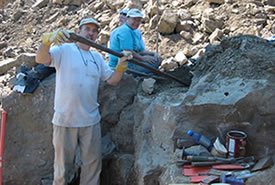 Bill uses a railroad tie-puller to open a cavity.
Bill uses a railroad tie-puller to open a cavity.  Duffy the Rockhound supervises the the dig.
Duffy the Rockhound supervises the the dig.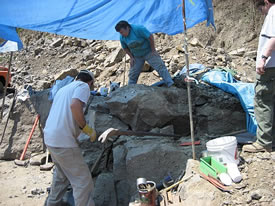 Later that afternoon - finally getting into the cavity!
Later that afternoon - finally getting into the cavity!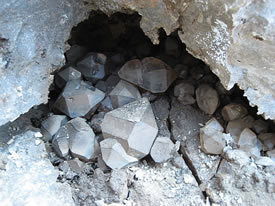 Paydirt! First look into a new cavity!
Paydirt! First look into a new cavity! 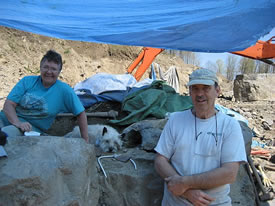
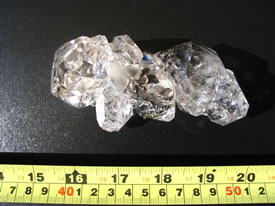 Large crystal cluster from cavity. Click to enlarge.
Large crystal cluster from cavity. Click to enlarge.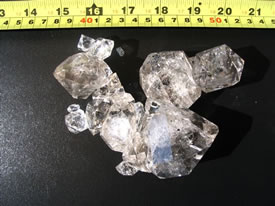 Another cluster - "The Squirrel". Click to enlarge.
Another cluster - "The Squirrel". Click to enlarge.